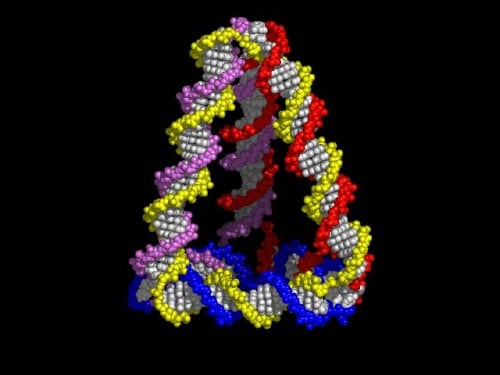A simple method to create robust DNA "pyramids" that self-assemble in seconds has been invented by physicists in the UK. Each side of the tetrahedral pyramid is made up of a double helix of DNA. The pyramids can then be joined together to make larger 3D nanostructures on which to build molecular electronic circuits and tiny containers for drug delivery (Science 310 1661).

DNA — the “building block of life” — consists of two linear strands wound into a double helix with one of four different “bases” attached to every sugar group along the strands. DNA is an attractive engineering material because strands with complementary base sequences recognise and bind to each other, enabling complex molecular structures to be made by self-assembly.
Previous attempts at making DNA nanostructures, in the shapes of cubes or octahedra, required many steps and did not produce much material. The new method, invented by Andrew Turberfield and Russell Goodman of the University of Oxford, overcomes this problem.
It creates nanoscale tetrahedra of DNA that self-assemble in a single step in just seconds with a yield of up to 95%. The tetrahedra are made from four short strands of synthetic DNA, each of which runs around one face. Each edge is formed where neighbouring strands have complementary base pairs.
The new method is simple and involves heating DNA strands in a salt solution to just below boiling point. When the strands are then rapidly cooled, they bond together to form a tetrahedron. The team can then link different tetrahedra together using single strands of DNA.
“Tetrahedra are used extensively in architecture and engineering because their structure is simple but very strong, making them ideal for use in DNA nanostructures,” says Turberfield. “These atomically precise nanostructures are ideal building blocks for nanofabrication and can be produced cheaply in large quantities – all you have to do is mix the components together.”
Indeed, colleagues at the Vrije Universiteit in Amsterdam showed that the tetrahedra can withstand forces of up to 100 picoNewtons by compressing them with the tip of an atomic force microscope. These compression tests also allowed the Anglo-Dutch team to measure the elastic properties of DNA for the first time.
The team now plans to make 3D scaffolds for molecular devices such as electronic circuits using linked tetrahedra. The DNA pyramids could also act as containers for individual protein molecules and so be used to deliver drugs.
“We have designed a family of DNA tetrahedra which are structurally stable and can be manufactured in a quick and simple step,” adds Turberfield. “Ultimately we hope to use them as building blocks for nanofabrication, to act as templates for much more complex DNA nanostructures.”



